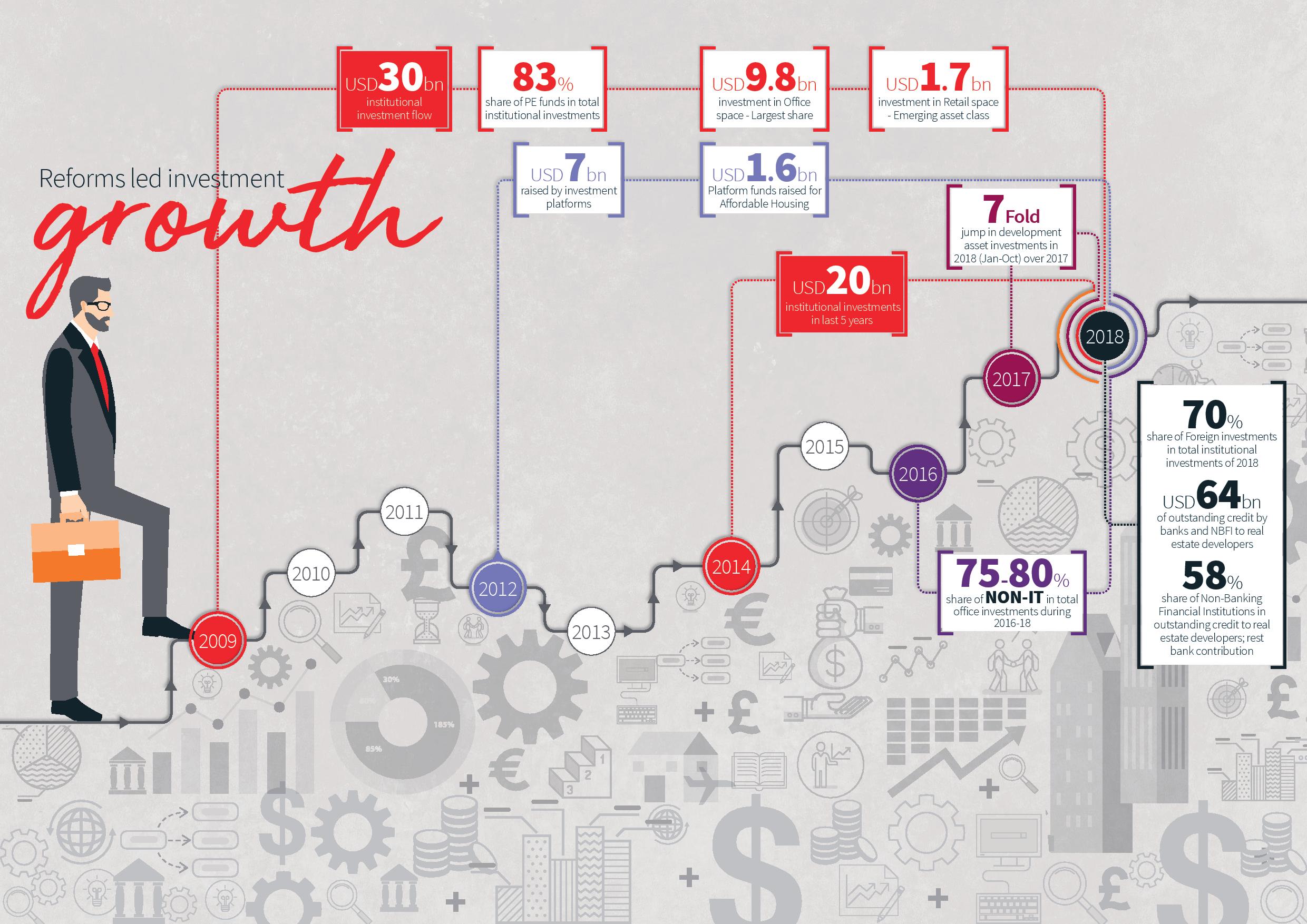Institutional Flow of Funds to Indian Real Estate: Trends and Progress
Share Institutional Flow of Funds to Indian Real Estate: Trends and Progress
JLL, India’s leading real estate professional services firm, today announced the launch of an exclusive report titled ‘Institutional Flow of Funds to Indian Real Estate: Trends and Progress’. The report analyses key trends in institutional investments in the real estate sector over the last decade and has estimated them to potentially touch $5.5 bn in 2018, which is the highest ever since 2009. As of Oct 31, the sector has recorded investments worth $4.2 bn. The report also highlights that institutional investments in 2014-2018 doubled to $20.3 bn compared to $9.4 bn received during 2009-2013.
Driving the growth in investments are factors like implementation of transformative policy reforms, stable macro-economic fundamentals, and growing risk appetite of foreign and domestic institutional investors. According to the report, the Indian real estate sector has attracted nearly $30 bn of institutional investments from January 2009 till October 2018.
According to Ramesh Nair, CEO and Country Head, JLL India, “India’s real estate sector is at an inflection point. While the investment scenario improved post the global financial crisis, there has been a surge in institutional investments into the sector since the beginning of the year 2014. The trend suggests that the market offers tremendous growth opportunities to foreign and domestic investors. Against the backdrop of an ongoing policy overhaul, rising investor confidence, enhanced transparency, gradual recovery in the residential segment, and an increasing demand for grade A commercial office space, the investment momentum is only expected to grow manifold from its current levels.”
In terms of cities, Mumbai, Delhi NCR and Bengaluru have been the preferred markets accounting for over two-third of institutional investments from 2009 till 2018. With 42% share of investments worth $8.6 bn in 2014-18, Mumbai is clearly ahead of other cities. It is followed by Delhi NCR and Bengaluru with $4.4 bn and $2.6 bn respectively. Among different types of institutional investors, the report states that private equity investors have contributed 80% or more of the overall institutional investment in the last decade.
The report shows commercial office segment emerging as the most favorable asset class for institutional investors with a five-fold increase in capital flows to $8.2 bn in 2014-18 from $1.6 bn in the preceding five year period starting 2009. With non-IT/ITeS companies emerging as demand drivers, share of institutional investments in non-IT office space has jumped manifold, ranging between 70-85% during 2016-18 as compared to 20% in 2009.
“One of the major drivers for the growing interest of investors in the commercial office space has been the government’s move to bring in progressive modifications in India’s REIT policy in last three years, making it more market friendly. As a result, global investors have invested significant capital in acquiring large office assets for building their REIT portfolios in India. In particular, 2017 and 2018 recorded maximum investments of $5.9 bn in the office space. This amounts to 72% of the total investments in the commercial office segment during 2014 to 2018,” said Samantak Das, Chief Economist and Head of Research & REIS, JLL India.
Besides commercial office segment, retail is another asset class that has also witnessed a sharp rise in investments. From just $134 mn during 2009-13, investments in retail surged by eleven times to $1.6 bn between 2014 and 2018.
Lending by Non-Banking Financial Institutions (NBFIs)
With lending by banks to real estate sector slowing down since FY2011-12, the report focuses on the role being played by NBFIs (includes non-banking financial companies and housing finance companies) in terms of outstanding credit to realty companies. From $13.4 bn in FY2011-12, outstanding credit has tripled to $40.2 bn in FY2017-18. This translates to a CAGR of 20%. In percentage terms, proportion of financing by NBFIs has increased to 58% in FY 2017-18 from 36% in FY 2011-12.
As far as NBFCs are concerned, developers have preferred to refinance existing loans to reduce interest costs. During FY2017 and FY2018, an estimated $14.4 bn was disbursed by NBFCs to the real estate sector. On the recent liquidity crisis being faced by NBFCs, the report notes that, though it is not a systemic risk, the real estate sector will face funding issues in the short-term. However, NBFCs affiliated to large corporate groups have steady asset quality and are likely to honour their short-term liabilities.
The report also articulates some interesting trends that will gain prominence in the next few years. The emergence of platform deals with increased focus on affordable housing, retail, industrial and warehousing sectors are the key trends to look forward to in the coming years.
Request a Call Back

